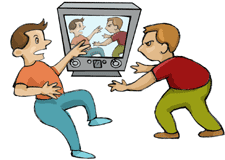Six Kinds of Screen Violence - And How Children Respond
The relationship between screen violence and street violence has been studied ever since the early days of television - some say over 3,000 studies in the past four decades. While it is too simplistic (and impossible) to "prove" that media portrayals "cause" violence in real life, there are more nuanced studies that explore how media violence is perceived by viewers or internalized in attitudes and/or behaviors.
In one interesting study, social science researchers Daniel Linz, Barbara J. Wilson and Barbara Randall first identified six different and distinct characteristics of "violence" in film and then explored how viewers of different ages and stages of maturity, responded.
The following summary provides an entrypoint for further discussion about what constitutes "violence" in media and ways that parents and caregivers might select or monitor their children's media.
- Reward for Violence
If a violent act is rewarded or left unpunished, it is more likely to foster attitudes supportive of aggression. The lack of punishment actually functions as a sanction or a reward for violent behavior. - Reality of Violence
The more a violent act is realistically portrayed, the more likely it is to be imitated. Older children are more emotionally responsive to programs that depict realistic events and are influenced more by violent movies that feature events that are humanly possible. - Violent Role Models
Children are more likely to imitate and look up to characters whose use of violence is portrayed as necessary or attractive. Moreover, children who strongly identify with a violent media character are more likely to be aggressive themselves.
identify with a violent media character are more likely to be aggressive themselves.
- Justified Violence
The more an act of violence is presented as justified, the more likely it is to be copied. Young children are more apt to hurt than to help a peer after watching a cartoon with scenes of justified violence. - Violent Connections
Viewers who find similarity between themselves and their actions and feelings and a violent act, theme or character in a film are more likely to imitate or emulate that violence in real life. This is particularly true of children. - Amount of Violence
Excessive exposure to media violence may produce a psychological blunting of normal emotional responses to violent events. It may also lead to a lack of responsiveness to real-life aggression.
Summarized from "Applying Social Science Research to Film Ratings: A Shift from Offensiveness to Harmful Effects, Part I," by Barbara J. Wilson, Daniel Linz and Barbara Randall, Journal of Broadcasting & Electronic Media, Volume 34, Number 4, Fall 1990.


